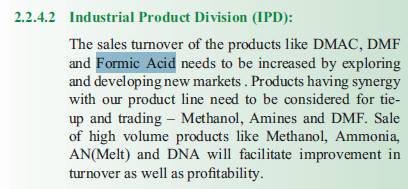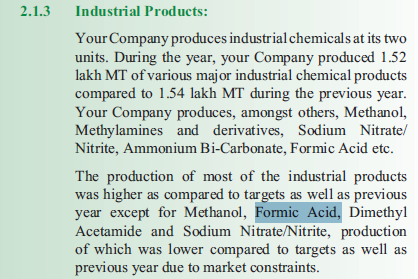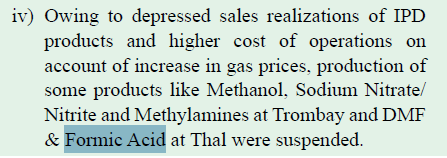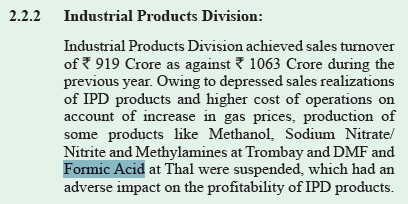@Capsule91 any update on the TDI prices domestically/internationally? Last price updated on Sheela foam is 300/Kg on 6th March.
Regards,
Suhag
@Capsule91 any update on the TDI prices domestically/internationally? Last price updated on Sheela foam is 300/Kg on 6th March.
Regards,
Suhag
No, no numbers are out yet…but basf further hiked prices… Strange!
But i got these excerpt …
1.
Dear Valued Customer,
Effective April 15, 2018, or as contracts allow, BASF Corporation is raising the price for all
Lupranate® TDI products by $0.10 per pound.
Your BASF Account Manager will provide details of this announced increase and is available to
answer any questions you may have. We appreciate your continued support with BASF
Urethane Chemicals.
…
Lupranate is just a brand name of polyurethane they priduce nothing else…
2.
The National Union of Polyurethane producers (SNPU) says that the market is returning to normal following a shortage of methylene diphenyl diisocyanate (MDI) in 2017. Prices of polyurethane insulation panels rose due to the lack of MDI, according to the Le Moniteur trade newspaper. The SNPU added that the market had stabilised since the start of 2018.
No cluewhats going on in tdi…
But i would like to share some interesting article which we longer term investors must be catious/interested about …
Sadara cyber attack threat…
A CYBERATTACK IN SAUDI ARABIA HAD A DEADLY GOAL. EXPERTS FEAR ANOTHER TRY.
By NICOLE PERLROTH and CLIFFORD KRAUSSMARCH 15, 2018
Photo
Sadara Chemical Company is a joint venture between Saudi Aramco and Dow Chemical. Its computer systems were hit by one in a string of cyberattacks last year. Credit Christophe Viseux for The New York Times
In August, a petrochemical company with a plant in Saudi Arabia was hit by a new kind of cyberassault. The attack was not designed to simply destroy data or shut down the plant, investigators believe. It was meant to sabotage the firm’s operations and trigger an explosion.
The attack was a dangerous escalation in international hacking, as faceless enemies demonstrated both the drive and the ability to inflict serious physical damage. And United States government officials, their allies and cybersecurity researchers worry that the culprits could replicate it in other countries, since thousands of industrial plants all over the world rely on the same American-engineered computer systems that were compromised.
Investigators have been tight-lipped about the August attack. They still won’t identify the company or the country where it is based and have not identified the culprits.
But the attackers were sophisticated and had plenty of time and resources, an indication that they were most likely supported by a government, according to more than a dozen people, including cybersecurity experts who have looked into the attack and asked not to be identified because of the confidentiality of the continuing investigation.
The only thing that prevented an explosion was a mistake in the attackers’ computer code, the investigators said.
The assault was the most alarming in a string of hacking attacks on petrochemical plants in Saudi Arabia. In January 2017, computers went dark at the National Industrialization Company, Tasnee for short, which is one of the few privately owned Saudi petrochemical companies. Computers also crashed 15 miles away at Sadara Chemical Company, a joint venture between the oil and chemical giants Saudi Aramco and Dow Chemical.
Within minutes of the attack at Tasnee, the hard drives inside the company’s computers were destroyed and their data wiped clean, replaced with an image of Alan Kurdi, the small Syrian child who drowned off the coast of Turkey during his family’s attempt to flee that country’s civil war.
The intent of the January attacks, Tasnee officials and researchers at the security company Symantec believe, was to inflict lasting damage on the petrochemical companies and send a political message. Recovery took months.
Energy experts said the August attack could have been an attempt to complicate Crown Prince Mohammed bin Salman’s plans to encourage foreign and domestic private investment to diversify the Saudi economy and produce jobs for the country’s growing youth population.
“Not only is it an attack on the private sector, which is being touted to help promote growth in the Saudi economy, but it is also focused on the petrochemical sector, which is a core part of the Saudi economy,” said Amy Myers Jaffe, an expert on Middle East energy at the Council on Foreign Relations.
Saudi Arabia has cut oil exports in recent years to support global oil prices, a strategy central to its efforts to make a potential public offering of shares of government-controlled Saudi Aramco more attractive to international investors. The kingdom has tried to compensate for its lost revenue by expanding its petrochemical and refining industry.
Some technical details of the attack in August have been previously reported, but this is the first time the earlier attacks on Tasnee and other Saudi petrochemical companies have been reported.
Security analysts at Mandiant, a division of the security firm FireEye, are still investigating what happened in August, with the help of several companies in the United States that investigate cyberattacks on industrial control systems.
A team at Schneider Electric, which made the industrial systems that were targeted, called Triconex safety controllers, is also looking into the attack, the people who spoke to The Times said. So are the National Security Agency, the F.B.I., the Department of Homeland Security and the Pentagon’s Defense Advanced Research Projects Agency, which has been supporting research into forensic tools designed to assist hacking investigations.
All of the investigators believe the attack was most likely intended to cause an explosion that would have killed people. In the last few years, explosions at petrochemical plants in China and Mexico — though not triggered by hackers — have killed several employees, injured hundreds and forced evacuations of surrounding communities.
What worries investigators and intelligence analysts the most is that the attackers compromised Schneider’s Triconex controllers, which keep equipment operating safely by performing tasks like regulating voltage, pressure and temperatures. Those controllers are used in about 18,000 plants around the world, including nuclear and water treatment facilities, oil and gas refineries, and chemical plants.
“If attackers developed a technique against Schneider equipment in Saudi Arabia, they could very well deploy the same technique here in the United States,” said James A. Lewis, a cybersecurity expert at the Center for Strategic and International Studies, a Washington think tank.
The Triconex system was believed to be a “lock and key operation.” In other words, the safety controllers could be tweaked or dismantled only with physical contact.
So how did the hackers get in? Investigators found an odd digital file in a computer at an engineering workstation that looked like a legitimate part of the Schneider controllers but was designed to sabotage the system. Investigators will not say how it got there, but they do not believe it was an inside job. This was the first time these systems were sabotaged remotely.
The only thing that prevented significant damage was a bug in the attackers’ computer code that inadvertently shut down the plant’s production systems.
Investigators believe that the hackers have probably fixed their mistake by now, and that it is only a matter of time before they deploy the same technique against another industrial control system. A different group could also use those tools for its own attack.
The August attack was also a significant step up from earlier attacks in Saudi Arabia. Starting on Nov. 17, 2016, computer screens at a number of Saudi government computers went dark and their hard drives were erased, according to researchers at Symantec, which investigated the attacks.
Two weeks later, the same attackers hit other Saudi targets with the same computer virus. On Jan. 23, 2017, they struck again, at Tasnee and other petrochemical firms, deploying a computer virus known as Shamoon, after a word embedded in its code.
The Shamoon virus first surfaced five years earlier at Saudi Aramco, wiping out tens of thousands of computers and replacing the data with a partial image of a burning American flag. Leon E. Panetta, the United States defense secretary at the time, said the attack could be a harbinger.
“An aggressor nation or extremist group could use these kinds of cyber tools to gain control of critical switches,” he said.
Government officials and cybersecurity experts in Saudi Arabia and the United States attributed the 2012 Shamoon attack to Iranian hackers.
“Another attacker could have adopted that code” for the January 2017 attacks, said Vikram Thakur, a senior researcher at Symantec, “but our analysis showed the likelihood it was the same perpetrator was pretty high.”
The attack in August was not a Shamoon attack. It was much more dangerous.
Investigators believe a nation-state was responsible because there was no obvious profit motive, even though the attack would have required significant financial resources. And the computer code had not been seen in any earlier assaults. Every hacking tool had been custom built.
The attackers not only had to figure out how to get into that system, they had to understand its design well enough to know the layout of the facility — what pipes went where and which valves to turn in order to trigger an explosion.
Investigators believe someone would have had to buy the same version of the Triconex safety system to figure out how it worked. The components, investigators said, could be purchased for $40,000 on eBay.
The attack has also shown the challenge of attributing with unquestionable evidence an attack to one country.
Security experts said Iran, China, Russia the United States and Israel had the technical sophistication to launch such attacks. But most of those countries had no motivation to do so. China and Russia are increasingly making energy deals with Saudi Arabia, and Israel and the United States have moved to cooperate with the kingdom against Iran.
That leaves Iran, which experts said had a growing military hacking program, although the Iranian government has denied any involvement in such attacks.
Tensions between Iran and Saudi Arabia have steadily escalated in recent years, and the conflict has drifted online.
United States officials and security analysts blamed Iranian hackers for a spate of attacks on American banks in 2012 and more recent espionage attacks on the airline industry. Iranian hackers were blamed for the 2012 Aramco attack and are also the leading suspects in the more recent Shamoon attacks.
The August attack was far more sophisticated than any previous attack originating from Iran, Mr. Thakur of Symantec said, but there is a chance Iran could have improved its hacking abilities or worked with another country, like Russia or North Korea.
Tasnee said in an email that it had hired experts from Symantec and IBM to study the attack against it. The company said it had also “completely overhauled our security standards” and started using new tools to prevent attacks.
“Being a global business,” the company said, “we believe that cybersecurity is a concern wherever you are in the world.”
Thanks for the details. I feel we will have to wait for the next updates from Sheela Foam to get a clue on the domestic prices. Should be out around first week of April based on their update frequency.
IMO, after recent correction the stock offers a good value ff TDI prices stabilize around Rs. 300/Kg.
Lets see how it pans out.
Regards,
Suhag
Basf geismer has come back online with full capacity of 1.6lakhmtpa in march 9th…
The demand supply constraints still exists if basf further increased tdi prices…
The situation i feel sud be under the microscope, as basf’s lagest one with 3lakhmtpa comes online in q1…
And then sadara…
With so much supply coming in, i personally think its better to monitor the situation before using the dip to increase position and that is my present stand…
TDI prices at 290 now as per Sheela Foam website.
This explains the weakness in the stock.
On a lighter note, we should switch from GNFC to Sheela Foam 
Management has been constantly trying to avoid the message that GNFC is only a TDI company. However, their revenues are tightly related to TDI (around 60%) and market is also valuing it based on that.
Q4 should still report good numbers considering the Y-o-Y TDI price is still higher than Q4FY17. Going forward, capex plans will play a key role of diversification from TDI. It will be interesting to see how their Neem venture is doing considering they have big plans for that.
Regards,
Suhag
I just wana add a bit, my uncle is a resident of gujarat, and as a former emplotee of a fertilizer company has good ties with gnfc n thier colleagues…
Recently he visited my place, n i was excited to know about the local advertisement of the neem products…
To my utter disapointment, he was completely uninformed about these neem products from gnfc! What inknow he is atleast a regular morning paper reader…
I know this is a spoonfull in the ocean example , but i didnt like this …
I have made up my mind to ask the management next tym in concall, whats the expenditure figures in the neem product marketting and advertisement…
Also amazon is charging too much shipping , multiplied by any number of order…
They can also atleast launch shipping n delivery system via their own e-platform…
I am not hopeful of capex even… a brownfield acetic acid wudnt aid to revenues much… although the demand is steady there…
On another line… We missed a big techincal indicator, whivh later i found out about…
There was classic wyckoff distribution going on at the top… Thats where the institutions were selling, the current downtrend will halt now, fot another distribution and then go further down…
Its like a head of a curve…!
All in all as reflected by tdi prices, the cycle is over, now we go in depression…
Atleast gnfc becme debt free n enough cash is left for new capex…
This cycle of chemicals made gbfc what it coudnt be all these years… Now all their failed plans can be seen to materialize one after another… The tm80 7800mtpa plant and mdi 50000mtpa plat which has veen in the books since 2007! Is in my radar which i am eagerly looking forward too…
The it n neem business is like a 50 50 workout for me… The margins as of now is horrible…
Incoming years mdi caoex will come and the gov of that day might put antidumping on mdi…
That will be serious stuff… mdi has much wider applications than tdi…
And i wud luv to see tm80 coming up…
There are very few producers of mdi tdi 80 20 blend in the world and gnfc has the plant layout prepared also, as i had posted here previously…
The story is good, and is interesting…
Lets see how myopic the market remains…
Disclaimer … Invested, no trading
Thanks for sharing the details. Would it be possible to get details about how are the current realizations of other chemical portfolio of GNFC from your uncle’s contacts? We know that they were also at peak at least till last quarter but we do not have much idea about last 2-3 months. TDI we can at least track thanks to Sheela foam but i do not have much idea on where we can track other chemicals regularly.
Regards,
Suhag
Nigel D’souza from CNBC TV18 travelled to GNFC last week during the holidays. We will have that exclusive interview @ 10:30AM on CNBC. Initial commentary looks very positive on TDI demands and export orders, working capital and many other things.
Tune in to get more details.
Regards,
Suhag
So, RCF has a 10,000MTPA capacity of formic acid… which if acquired will increase gnfc current capacity to 30,000MTPA…
Here the the scrapings from AR’s of the last 3 years regarding formic acid…
Now the plant is shut down…
there was a provisioning for impairment of 3.87cr in 2014-2015
Then production drastically fell in 2015-12016…
1.AR 2014-2015
excerpts…


2.AR 2015-2016

3.AR2016-2017


So the capacity utilization in the formic acid plant was 56% in 2013… there after is declined…
An interesting article to be noted,…
Disclaimer… intevested
was visiting gnfc website…
2 things caught my eyes…
1.https://www.gnfc.in/PDFandWORD/Notice_AMMONIA.pdf
GNFC intend to procure approx. 6,300 MT Liquid Anhydrous Ammonia
2.https://www.gnfc.in/PDFandWORD/Guidelines-for-the-appointment-of-TDI-Dealers.pdf
Looking to growing market for Toluene
Di-Isocyanate (TDI) in India, GNFC is interested in appointing Dealers for
this product. Companies interested in expanding their business and
sourcing products from GNFC may apply separately through e-application
only, available on our website www.gnfc.in along with three years C.A.
certified balance sheets / financial statements, Import/ export potential of
above Chemicals, giving full details of organization, details of their
experience in marketing of Industrial Chemicals and / or Fertilizers in India.
here is the advertisement the above is extracted from…
https://www.gnfc.in/PDFandWORD/Advertisement.pdf
As far as ammonia is concerned , gnfc already has a huge capacity…
this additional requirement can be due to some plant shutdown for about a week or true requirement…
the ammonia plant generates 8567MT/ week… here the requirement is lesser than that…
eitherwise minuscule to be considered
I specially am impressed by the advertisement for inviting dealers in tdi…
In the interview the MD says there is not a threat by the supply lines coming up…
Dow whereas mentioned the target market for sadara is same as gnfc, east africa, southeast asia including india…
Infact our MD mentions that the demand is growing nicely from africa…
repeated such statements coming from a ultra uptight management, is calming down my tensions regarding the future tdi price trends…
still it is prudent to note, that covestro, basf and dow all mentioned that the tdi prices will soften in this year… (i have reported the excerpts in my previous posts already )
with reference to my earlier post about rcf formic acid plant…GNFC - Turnaround Taking Hold
the 2014-2015 number is Rs.46/kg was the price of forming acid back then…
i only found one dealer selling in gujarat , 85% formic acid from gnfc at Rs.78/kg
Rcf generated 25.16cr from forming acid with capacity utilization of about 55%, at that price of 2015, the full capacity utilization would have generated 46cr annually in topline…
Almost same as the ebit from ecophosJV that is expected…
Hope they get this plant and the cash in coming times…
Disclaimer… Invested, maintaining initial positions…
Now that they are debt free street will keenly watch how the cash on books is being utilized.
Debt Free - Interest cost gone
Working capital down by a huge amount - savings
Ecophos JV to have positive contribution starting H2FY19
All these will add to the free cash flow. One of the things which bothers me is there are no firm news on utilization of cash or Capex. We keep on hearing different things at different times from the same management.
RCF plant even if materialize, will take years to complete M&A as both are govt entities and we all know slowly things work out there.
Also, CMD was understandably trying to avoid questions related to TDI prices. He was more focused on demand. Plant of TDI 1 is operating @ 100% capacity where as TDI 2 plant is also above 85%. Even if there is more demand where will the supply come from GNFC? So its important for the TDI prices to remain stable around current levels.
Disc: Invested and planning to add more around current levels.
Regards,
Suhag
That was also the first thing that hit me… Once we hear acetic acid, then mdi, the smart city , now some fairytale formic acid story…
I remember back in q2 concall the management mentioned brownfield in formic acid… if this was the source of that brownfield , its utterly subsense statement…
But yiah the management said, they will do capex in their area of experience…
See, this is the reason i hate this management, they dont speak out clearly…they dont gv visibility… how will the market discount good things withour visibility n give premium…
And the hcl lifting cost is changing constantly , in q2 there was one number, i was given a diff reply in q3 n this interview said sometHing i cannot comprehend, who kwns whats ecophos is bringing, but i had a calculation of 46cr as per q3call number…
Lastly, yiah, he is focussing on demand in tdi… For some reason i like that perspective from him…
Its easy to get the supply numbers…
But the demand scene is a field job to quantify…
If he is repeatedly saying the demand is too much to absorb the supply coming up, i will gv him the benefit of doubt…that can infact maintain tdi prices, any maintainance above 4000usd wont hurt the numbers much , and a 50_52eps can be maintained for the next yr and a bit more with ecophos in the fold generating 4eps annually from h2fy19 …
Again i am so disapointed, about the neem side, there is no mention of marketting strategy! What will help by making mkre variety if its not marketted… Hope they do sometHing about that…
Anyways, we here will be analysing tdi a lot in this coming year… too much action packed a year thiss will be…
Another thing before i miss, china polyurethane market is starting, wanhua is doing capex in china, for the next 3 years…
Disclaimer… Inveated, maintaining intitial positions
TDI prices back to Rs. 300/Kg. This justifies the recent statements of CMD that its fluctuating in a range. No clear downtrend as of now.
Regards,
Suhag
Thanks!
Prices in china are around 4530 to 4610usd presently
Current borrowings will be there always to fund the business…finance costs due to these short term loans are minute…
I dont think anyone should be concerned about that…
If dbt was applied then intially the working capital needs would have been more intense, thats not there also…
Yes, neem division is just a fetus but we have to be patient here to unlock its value…
Please provide the source of this information pertaining to gnfc specifically…
Please mention specific red flags u see, we are all in for hearning about the negatives…
Well for CSR fund, you can just google through the news, recent being buying cows in Amethi, there are few other similar things.
Well if a company is making profits and claiming reduction in financing cost,
I feel that must show in cash flow statement,
Good operating cash yet higher short term borrowings doesnot add up.
Neem FMCG is in foetus stage urea neem coat isn’t, where is the revenue?
CSR news were denied by the company on the same day it surfaced. Its more of a political play so i would not read much into it unless a clear link is established with GNFC.
I think many forum members have contributed here to evaluate GNFC both on positives and negatives. Would request you to go through the thread to understand it better and then give your views.
Regards,
Suhag